The Walbridge Fire, which burned more than 55,000 acres in the hills West of Healdsburg in Fall of 2020, had a lasting impact on the land and its waterways. More than 150 homes were lost, and rebuilding, revegetation, and soil recovery will continue for years to come.
Many of the creeks in the Walbridge Fire zone are extremely important tributaries for endangered salmon and steelhead. The Russian Riverkeeper field crew worked very hard to isolate toxic pollutants and prevent sediment from entering creeks that flow into the Russian River. We spent several months installing straw wattles around burned structures and vehicles, pinning down biodegradable fabric on unstable banks, and spreading native seed over disturbed areas for erosion control. Then we moved on to the Glass Fire and worked a few more months across the Russian River Valley.
While managing the crew (during the pandemic) and moving from one devastated property to the next, we got to know the impacted property owners and their struggles to persevere after such devastating losses. It was strenuous, emotional, and gratifying work, and thanks to financial support from Sonoma County, and our generous donors and members, we were able to help many property owners.
We recently re-visited some of the work sites to gauge how effective our treatments were after last year’s rains. We were delighted to see an abundance of diverse plant cover, butterflies pollinating wildflowers, birds still flying about, and what appeared to be young salmon in the creek. We even met a very nice couple while stopped on the road, to learn that we had worked on their properties last year, which included the historic Daniels Schoolhouse. Their family’s land had been loved for many generations dating back to the 1800s, and although they all lost their homes in this fire, they had not lost their love for the land.

Fresh growth under burnt trees.

Straw wattles containing erosion & saving fish.
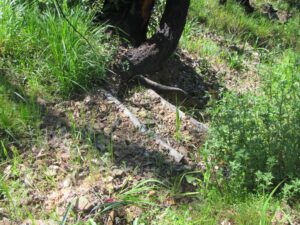
Fire-destroyed tree trunks repurposed to protect the hillside.
Upon re-visiting their property, we noticed that virtually nothing had changed since we left it in January 2021. It was peaceful and full of life. The burned trees and shrubs were mostly all re-sprouting fresh growth. The fabric work that we laid on the road cut was still in pristine shape (first photo), with a diversity of plants sprouted up through it from the “Holdfast Native” seed mix from LeBallister’s that we had spread across the barren and fragile land. The seed mix contains lupines, poppies, California Brome, Blue Wild Rye, and California Fescue. This thick growth of groundcover is very effective at absorbing any toxins from the runoff that flows into it while stopping erosion. The straw wattles that we had installed were holding fast and had held back a tremendous amount of runoff sediment, in the drainage washes that led directly to Mill Creek (2nd photo). We also tried installing cut dead wood check-dams in the drainages, which worked perfectly (3rd photo). It was extremely satisfying to see how well these Best Management Practices (BMPs) had held up and how effectively they served their purpose of slowing down erosion and protecting the stream.
On other properties, there was no sign of our work, as machinery carelessly drove over, tore apart, or removed the wattles. Some of the affected property owners had logged all of the big trees, leaving behind an environment that is no longer recognizable and has changed the shaded micro-climate into something different (1st and 2nd photos). Time will tell what sort of impact this will have on the ecosystem, especially through this historic drought that we are facing. At least all the logging activity produced copious amounts of wood chips that were spread across the disturbed soil. Some properties had lost a lot of topsoil due to erosion that should have been slowed down with proper BMPs (3rd photo). One property had an excavator operating with two crewmembers with chainsaws, cutting down trees and burning several piles of cut limbs all over the hillside. It was an apocalyptic scene, and it displayed the difference in stewardship mentalities. The upside of the current drought is that all the disturbed sediment from the logging and machinery will not have such a bad impact as if it were a rainy season. They should have time this summer to install proper BMPs and do what is right to protect these rare jewels of salmon-bearing streams into our Russian River. The future survival of these endangered fish depend on all of our efforts to protect the water quality and stream habitat.
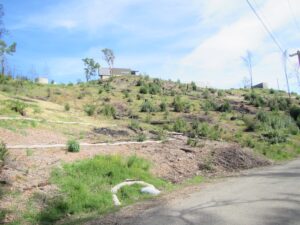
Previously wooded hillside cleared.
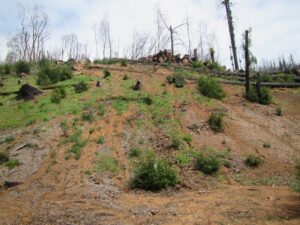
Clearcut hillside no longer provides shade, habitat, or hillside stabilization.
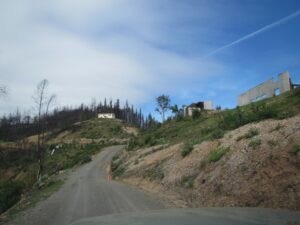
Depressing scene of destroyed home compounded by hillside without ecological regeneration.
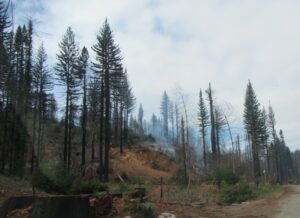
Burn piles.
